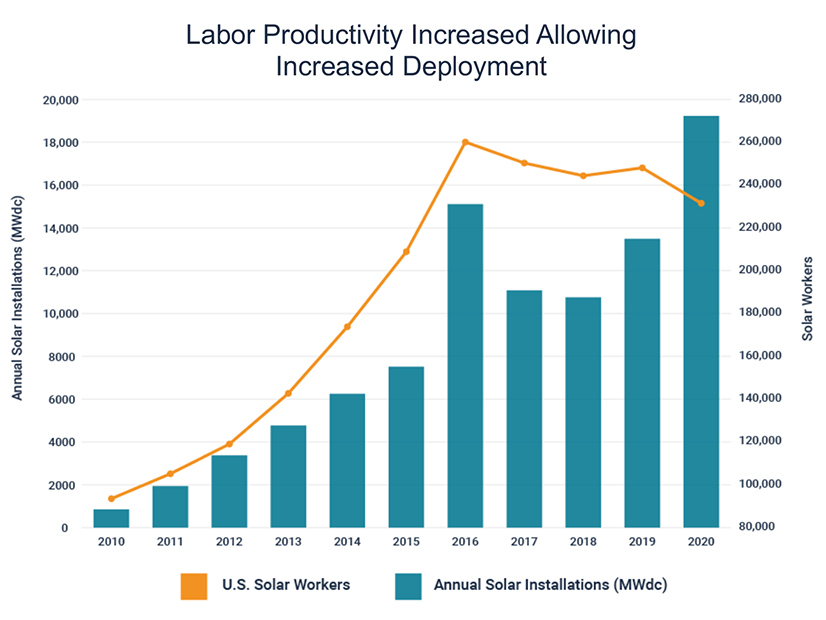Solar industry employment fell 6.7% in 2020 due to COVID-19 pandemic restrictions and increased labor productivity, while the sector installed a record 19.2 GWdc, in part, because of those productivity gains, a new report shows.
Solar jobs fell to 231,474 last year, their lowest level since 2015, in response to lockdowns that halted most residential and commercial installations last spring, according to the National Solar Jobs Census 2020, released Thursday by the Solar Energy Industries Association (SEIA), The Solar Foundation, the Interstate Renewable Energy Council (IREC), and BW Research.
“The U.S. solar energy industry was on track for a record year in 2020 with both installations and employment expected to reach all-time highs,” the report said. “Installations were already up through February 2020 and initial impacts on the industry were limited to concerns about global supply chains until COVID-19 took hold in the U.S., triggering stay-at-home orders and other protocols that impacted many industries, including solar.”
Many local governments struggled to process building permits before converting to remote or online systems, resulting in backlogs after installations resumed, the report said.
Utility-scale deployments accounted for 73% of all new solar installations last year, a new record.
“Because utility-scale projects use fewer installation workers per kilowatt deployed, the increase in utility-scale market share allowed for greater deployment with lower labor intensity,” with productivity in that sector increasing by 32%, the report said.
Residential productivity also improved by 19%, with non-residential (commercial and community solar) projects seeing a narrower 2% productivity gain.
The residential sector accounted for 55% of solar jobs, followed by 19% in utility-scale, 18% in commercial and 8% in community solar.
Installers represented 67% of all job types, with total employment in that field falling 4.2% to 154,610, mostly due to declines in residential and commercial installations. Manufacturing-related jobs dropped by 9.3% to 31,050 as production slowed to accommodate social-distancing requirements and some factories shut down temporarily.
Sales and distribution jobs took the biggest hit, declining by 12.2% to 25,663. “This category relies heavily on demand from the installation and manufacturing segments. As deployment and production slowed, wholesale and retail trade and distribution [were] also impacted, leading to employment reductions,” the report said.
The report also noted that the solar sector is becoming more diverse, with women accounting for 30% of the workforce last year compared with 26% a year earlier. Women are employed in industry at three times the rate of the construction industry at large, the report said.
Since 2015, as solar employment has grown 11% overall, employment has increased by 93% for women, 92% for Hispanic or Latino workers, 73% for Black or African American workers, 18% for Asian workers, and 19% for veterans. About 10.3% of solar workers are unionized, compared with the 10.8% rate for U.S. workers overall.
“This is despite a significant share of solar employment being in the home improvement sector with a large share of sole proprietorships where unionization does not apply,” the report said, referring to residential installations.
California Still Dominant
California accounted for the largest share of solar jobs, with 68,677 residents employed in the industry, down 7.5% from 2019. Rounding out the top five were Florida (11,219 jobs; -8.1%), New York (10,214 jobs; -4.9%), Texas (10,008 jobs; -1.7%) and Massachusetts (9,495; -8.7%).
“States with large distributed solar markets experienced the most employment loss, as residential and commercial segments were hit hardest by work restrictions and have yet to fully recover,” the report said. “Markets with larger shares of utility-scale deployment fared somewhat better, though those labor forces were also reduced by workers missing time due to the pandemic.”
The top five states for solar employment per capita were Utah, Nevada, California, Vermont and Hawaii.
The report shows that under current trends — “without significant policy shifts” — the solar and storage industries will employ about 400,000 people in 2030. Meeting President Joe Biden’s goal to decarbonize the grid and increase domestic manufacturing will require more than 900,000 solar workers by 2035, the report said.




